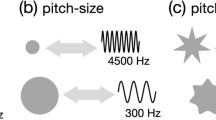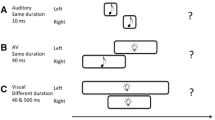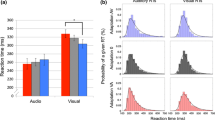Abstract
Simultaneous changes in visual stimulus attributes (such as motion or color) are often perceived to occur at different times, a fact usually attributed to differences in neural processing times of those attributes. However, other studies suggest that perceptual misalignments are not due to stimulus attributes, but to the type of change, first- or second-order. To test whether this idea generalizes across modalities, we studied perceptual synchrony of acoustic and of audiovisual cross-modal stimuli, which varied in a first- or second-order fashion. First-order changes were abrupt changes in tone intensity or frequency (auditory), or spatial position (visual), while second-order changes were an inversion of the direction of change, such as a turning point when a rising tone starts falling or a translating visual blob reverses. For both pure acoustic and cross-modal stimuli, first-order changes were systematically perceived before second-order changes. However, when both changes were first-order, or both were second-order, little or no difference in perceptual delay was found between them, regardless of attribute or modality. This shows that the type of attribute change, as well as latency differences, is a strong determinant of subjective temporal alignments. We also performed an analysis of reaction times (RTs) to the first- and second-order attribute changes used in these temporal alignment experiments. RT differences between these stimuli did not correspond with our temporal alignment data, suggesting that subjective alignments cannot be accounted for by a simple latency-based explanation.








Similar content being viewed by others
References
Alais D, Burr D (2004) The ventriloquist effect results from near-optimal bimodal integration. Curr Biol 14:257–262
Arnold DH, Clifford CW, Wenderoth P (2001) Asynchronous processing in vision: color leads motion. Curr Biol 11:596–600
Arrighi R, Alais D, Burr D (2004) Neural latencies do not explain the auditory and audio-visual flash-lag effect. Vision Res (in press)
Aymoz C, Viviani P (2004) Perceptual asynchronies for biological and non-biological visual events. Vision Res 44:1547–1563
Bertelson P, Aschersleben G (2003) Temporal ventriloquism: crossmodal interaction on the time dimension. 1. Evidence from auditory-visual temporal order judgment. Int J Psychophysiol 50:147–155
Brebner J, Welford A (1980) Introduction: an historical background sketch. Academic, New York
Fujisaki W, Shimojo S, Kashino M, Nishida S (2003) Recalibration of audiovisual simultaneity by adaptation to a constant time lag. J Vis 3:34
Galton F (1899) On instruments for (1) testing perception of differences of tint and for (2) determining reaction time. J Anthropol Inst 19:27–29
Hartmann W (2000) Signals, sound and sensation. Springer, Berlin Heidelberg New York
Jaskowski P (1993) Selective attention and temporal-order judgment. Perception 22:681–689
Kopinska A, Harris LR (2004) Simultaneity constancy. Perception 33:1049–1060
Moutoussis K, Zeki S (1997) A direct demonstration of perceptual asynchrony in vision. Proc R Soc Lond B Biol Sci 264:393–399
Nishida S, Johnston A (2002) Marker correspondence, not processing latency, determines temporal binding of visual attributes. Curr Biol 12:359–368
Reeves A, Sperling G (1986) Attention gating in short-term visual memory. Psychol Rev 93:180–206
Roufs JAJ (1963) Perception lag as a function of stimulus luminance. Vision Res 3:81–91
Shore DI, Spence C, Klein RM (2001) Visual prior entry. Psychol Sci 12:205–212
Spence C, Shore DI, Klein RM (2001) Multisensory prior entry. J Exp Psychol Gen 130:799–832
Stelmach LB, Herdman CM (1991) Directed attention and perception of temporal order. J Exp Psychol Hum Percept Perform 17:539–550
Titchener E (1908) Lectures on the elementary psychology of feeling and attention. Ayer, New York
Viviani P, Aymoz C (2001) Colour, form, and movement are not perceived simultaneously. Vision Res 41:2909–2918
Welford A (1980) Choice reaction time: basic concepts. Academic, New York
Zampini M, Shore DI, Spence C (2003) Audiovisual temporal order judgments. Exp Brain Res 152:198–210
Acknowledgements
We acknowledge support from the Italian Ministry of Universities and Research and an Australian Research Council grant (DP0345797) to D.A.
Author information
Authors and Affiliations
Corresponding author
Rights and permissions
About this article
Cite this article
Arrighi, R., Alais, D. & Burr, D. Perceived timing of first- and second-order changes in vision and hearing. Exp Brain Res 166, 445–454 (2005). https://doi.org/10.1007/s00221-005-2384-9
Received:
Accepted:
Published:
Issue Date:
DOI: https://doi.org/10.1007/s00221-005-2384-9




